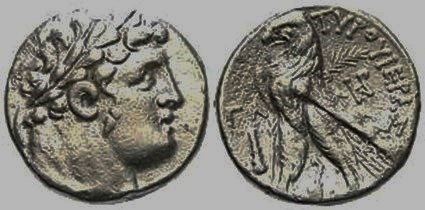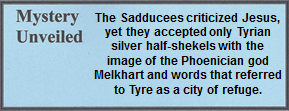11.02.03 Mt. 17:24-27 Capernaum, March, 29.
COIN FROM THE MOUTH OF A FISH
24 When they came to Capernaum, those who collected the double-drachma tax approached Peter and said, “Doesn’t your Teacher pay the double-drachma tax?”
25 “Yes,” he said.
When he went into the house, Jesus spoke to him first, “What do you think, Simon? Who do earthly kings collect tariffs or taxes from? From their sons or from strangers?”
26 “From strangers,” he said.
“Then the sons are free,” Jesus told him. 27 “But, so we won’t offend them, go to the sea, cast in a fishhook, and take the first fish that you catch. When you open its mouth you’ll find a coin. Take it and give it to them for Me and you.”
This event refers to the half-shekel temple tax that was instituted by Moses[1] and, according to the Oral Law, it had to be paid by the 15th day of Adar (March).[2] Only men who were aged twenty or older were required to pay the tax. This tax supported the tabernacle in ancient times. Later it supported Solomon’s temple followed by the second temple. Those who did not pay in Jerusalem could do so at a city such as Capernaum.[3]
The required coinage for payment of the temple tax (Mt. 17:24-27) is an excellent example to highlight the depraved and decadent nature of the Sadducees. In the days of Jesus, Caiaphas had a small army of tax collectors who secured funds to defray the expenses of the temple. Messengers, known as shelihim,[4] were sent out from Jerusalem to collect the required taxes. The collection in the Holy Land began on the first day of Adar, which is in the modern February and March calendar. The collection continued until Passover in Nisan. Money exchangers also went to the various towns and exchanged foreign currency for shekels that were minted previously by Simon the Maccabee. In foreign countries, every city where there was a Jewish population, a central collection point was established were the taxes could be paid. These funds were later shipped to Jerusalem and used for temple maintenance. Whether one gave a drachma or other coin, the Sadducees always demanded the Tyrian silver shekel.[5] Neither Jewish nor Roman coins were acceptable, but only the Tyrian silver half-shekel because of its silver purity and consistent weight.[6] It did not matter that the coin had the image of the Phoenician deity Melkhart (or Melqarth-Herakles) on the obverse side and on the reverse side, appeared an eagle on the bow of a ship with the legend: “Tyre the Holy and City of Refuge,” and the date of issue. This greatly offended righteous Jews as well as a great many Pharisees. They had to pay two taxes.
- A tax was due to the Roman Empire, and included the funding for Herod the Great and/or his sons.
- A temple support tax of a half-shekel (Ex. 30:11-16).

11.02.03.A. THE TYRIAN SILVER HALF-SHEKEL. The Tyrian Silver shekels were minted in the Phoenician cities of Acco and Tyre between 126 B.C. and A.D. 66 and replaced the Greek coins of Alexander the Great. Tyrian shekels had a minimum of 92 percent silver content, had images of pagan kings (deified), an aggressive eagle, and Marduk, a/k/a Melqarth-Herakles, the Tyrian god, and were the coins of choice by the Sadducees. Some scholars believe that only after the Romans shut down the Phoenician mint in 18 B.C. did the Jews mint their own silver shekels near or in Jerusalem.
However, there was a problem: To circumvent the first and second commandments (Ex 20:3-4; Deut. 4:16-18, 5:8), that Sadducees was said that the pagan stigma was removed if the coin was placed in a box rather than conveyed personally to a priest or other temple official. Those who had other currencies, including Jewish coins from the Maccabean Period, had to exchange currencies with money changers who charged a set 8% fee.[7] Ironically, it was this conflict of Jewish vs. Greek values that had previously sparked the Maccabean Revolt. Now the Jewish leaders required coins with the image of a pagan deity and statement that Tyre was the holy city, not Jerusalem.
The disrespect for the biblical commandments goes beyond merely accepting the pagan shekel of a foreign nation. Nonetheless, the Sadducees wanted their silver shekels, probably so they could charge high conversion rates to the thousands of Jews who did not have them. To compensate for the loss, a new mint suddenly appeared. Some scholars believe that a Jewish mint opened near Jerusalem where Tyrian shekels were produced between the years 18 B.C. and A.D. 69/70.[8] Not only did the Sadducees demand Tyrian shekels, but it appears that they had their hands in the production of them as well. How extensive their participation was is unknown, but the level of corruption is beyond imagination.
Jesus again demonstrated a lesson in humility. He was King of kings and Lord of lords and yet recognized those who held religious power and authority. Because priests and prominent rabbis were exempted from the tax, neither He nor His disciples were required to pay the tax either. However, for the purpose of preventing a conflict with the temple tax collectors, the tax was paid anyway to a religious system that had become corrupt and spiritually dead.

“Double-drachma.” A Greek drachma was the wage paid for two days of labor. In terms of monetary exchange, a half shekel equaled two drachma and a drachma was equal to the Roman Denarius.[9]
Video Insert >
11.02.03.V The Fishing Miracle of Humility. Professor Gordon Franz discusses Matthew 17:24-27 where Jesus demonstrated humility when paying the temple tax (5:23).
[1]. Exodus 30:11-16. See also 2 Kings 12:4; 22:3-7 and Nehemiah 33-34.
[2]. Mishnah, Shekalim 1:1; Smith, Augsburg Commentary on the New Testament: Matthew. 212-14.
[3]. Franz, http://www.lifeandland.org/2009/02/the-tyrian-shekel-and-the-temple-of-jerusalem/ Retrieved October 10, 2014; Franz, “Does Your Teacher not Pay the Temple Tax?” 81-82.
[4]. Geikie, The Life and Words of Christ. 2:264.
[5]. Franz, “Jesus Celebrates Hanukkah.” 116-19.
[6]. Kadman, “Temple Dues and Currency.” 1:9-10.
[7]. Hendin, Guide to Biblical Coins. 114-16.
[8]. Franz, http://www.lifeandland.org/2009/02/the-tyrian-shekel-and-the-temple-of-jerusalem/ Retrieved Oct. 20, 2014. Not all scholars agree on the date of minting coins near the Holy City in this time frame, as others believe it was during the First Revolt (A.D. 66-70), and possibly in the city at that time.
[9]. Gilbrant, “Matthew.” 369; Appendix 20.